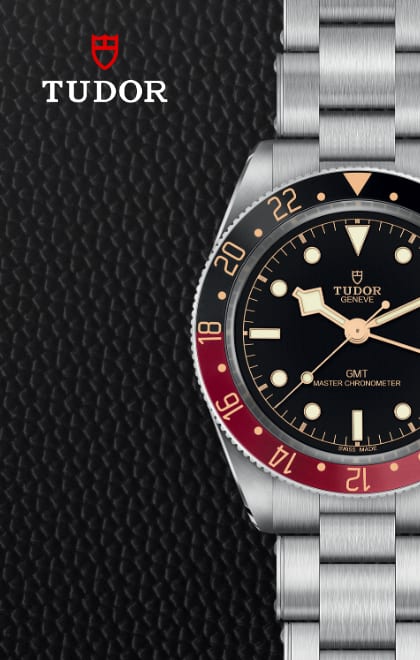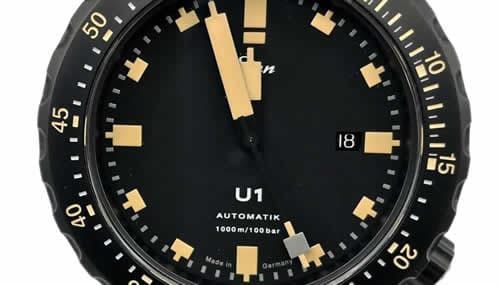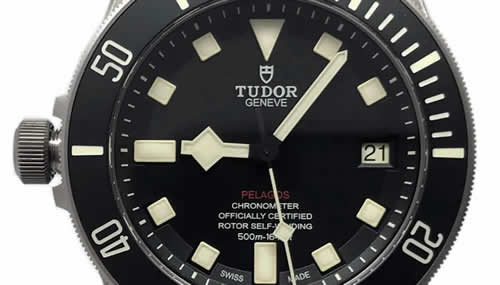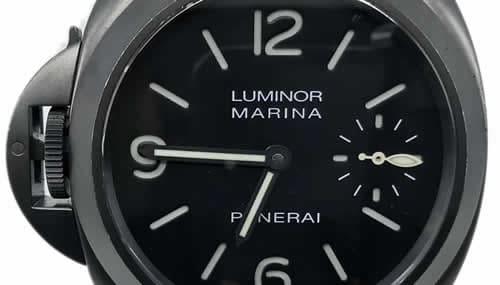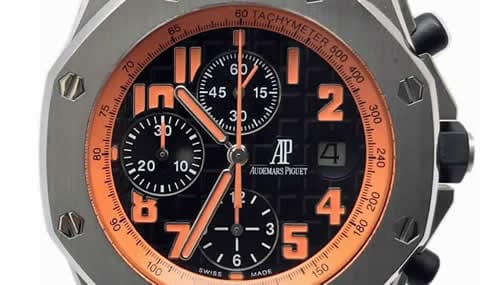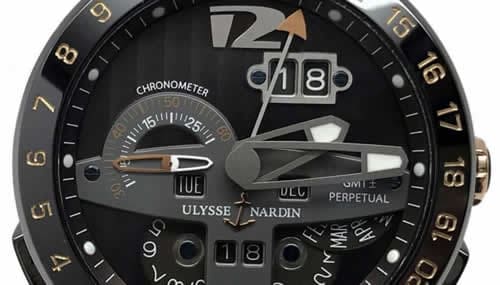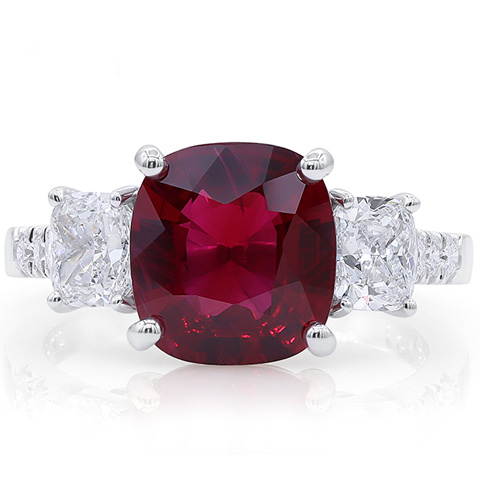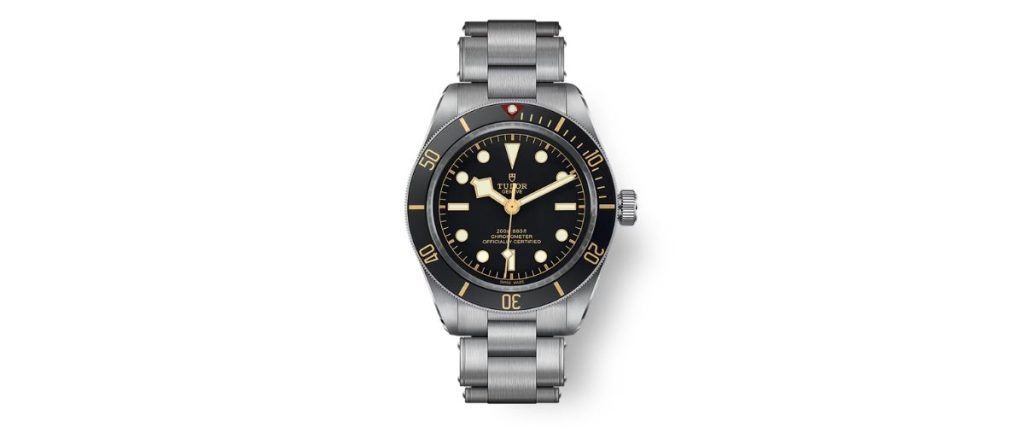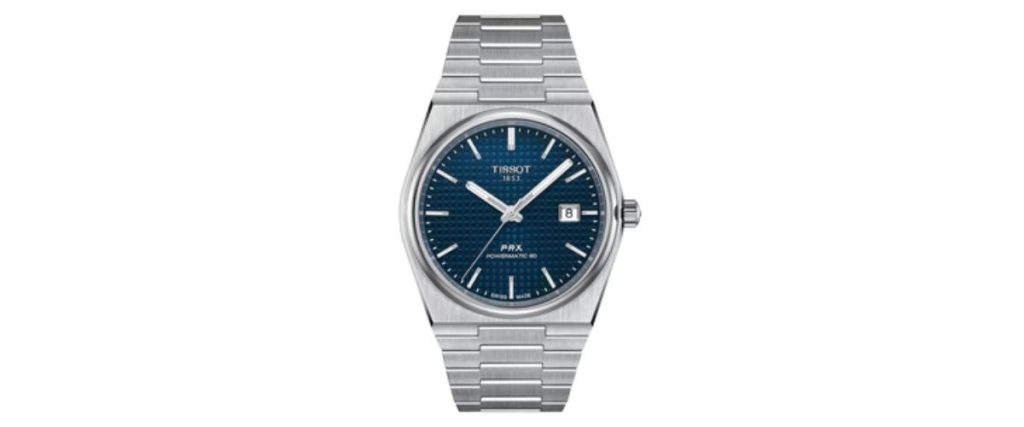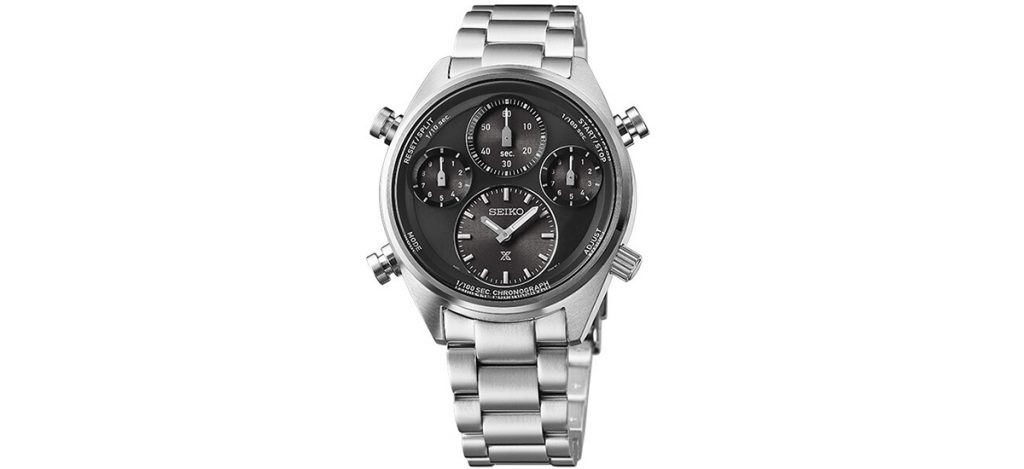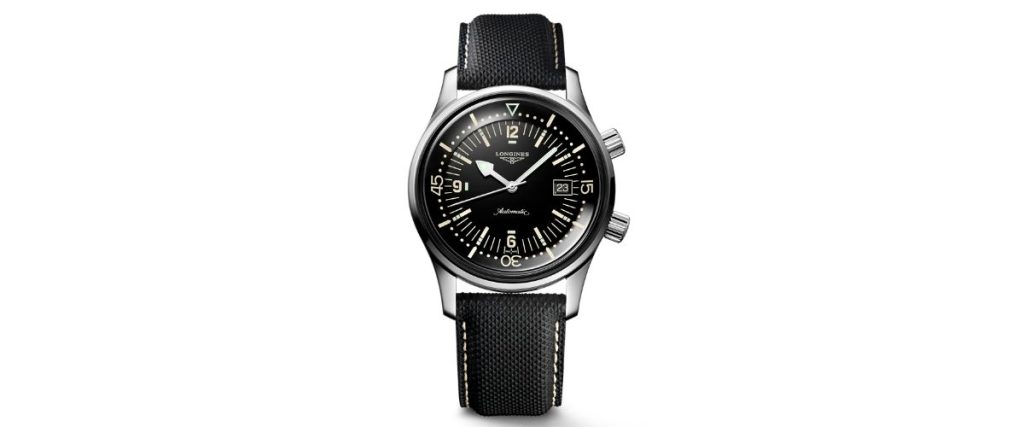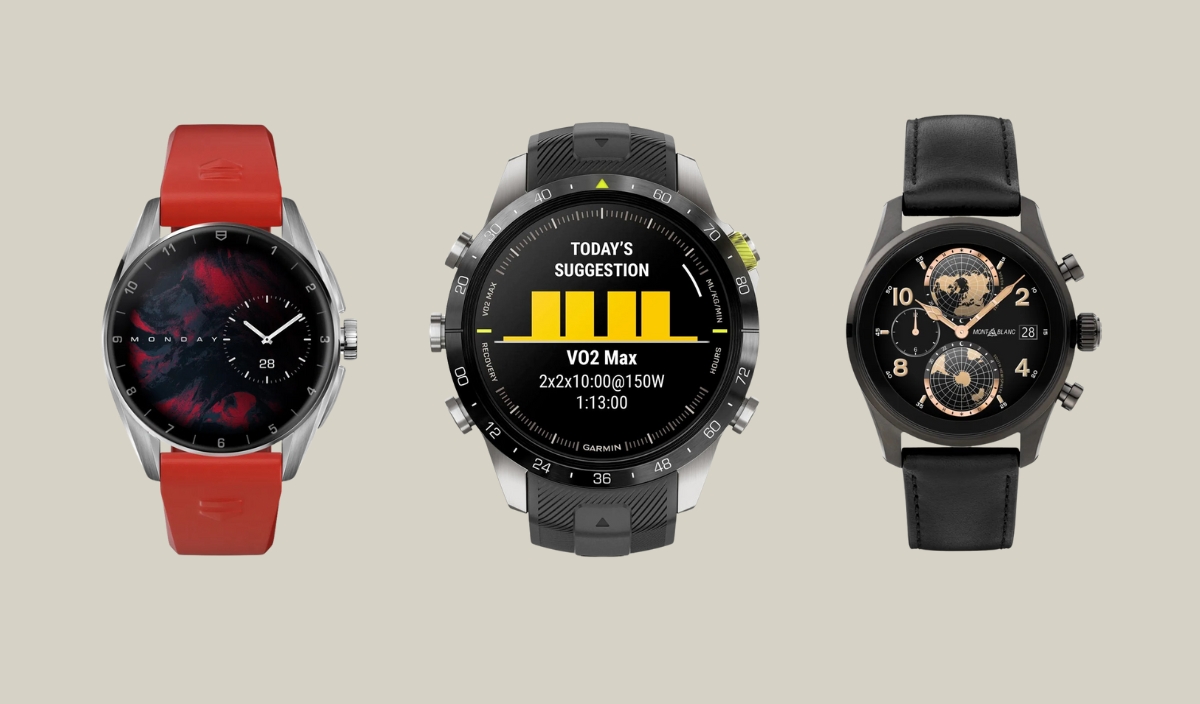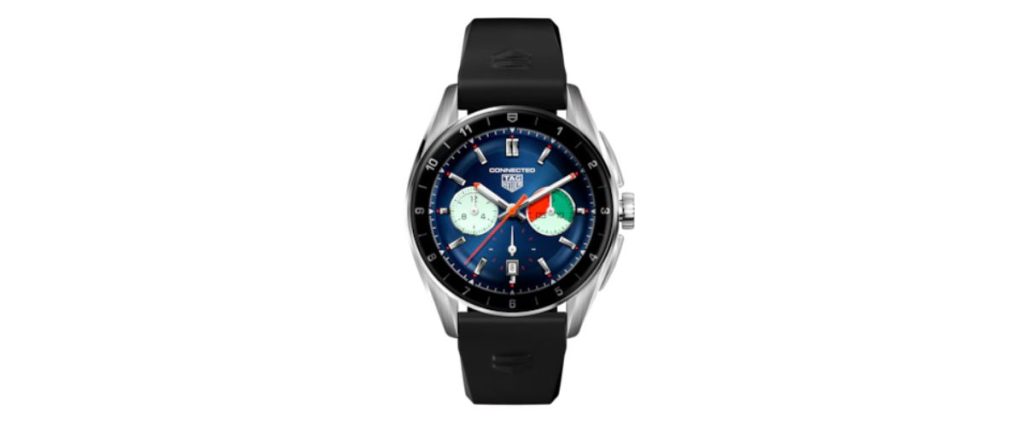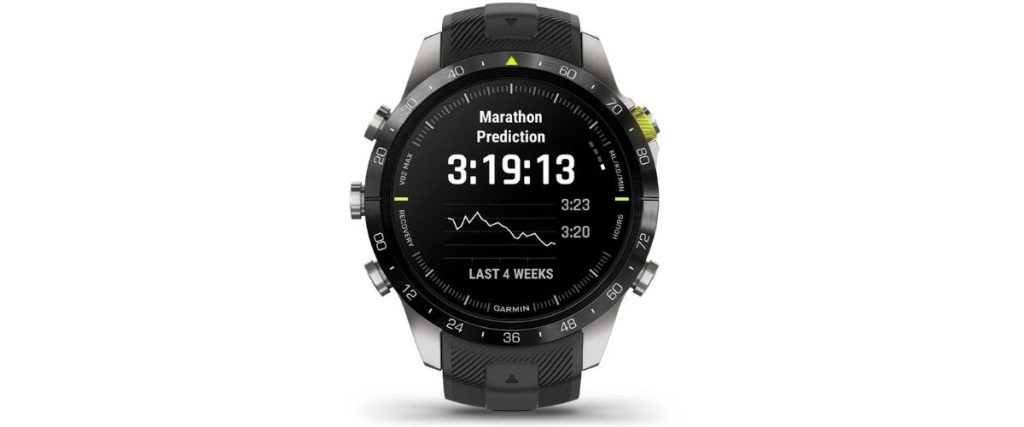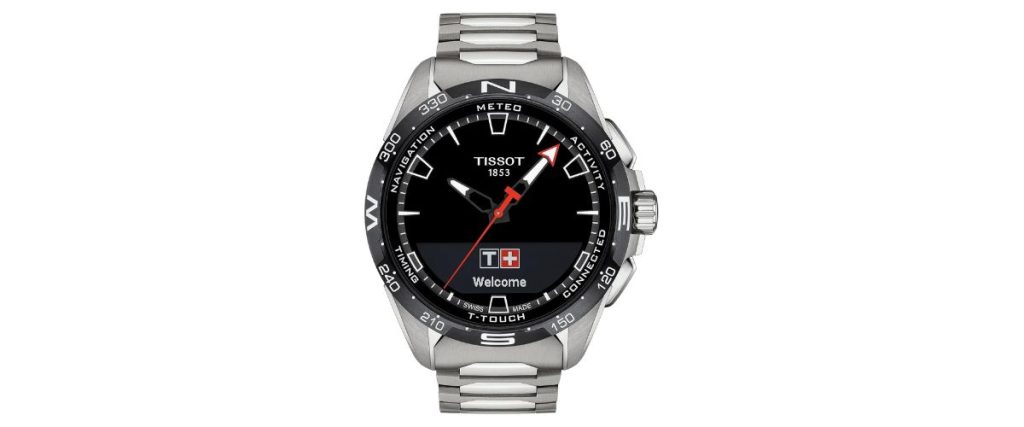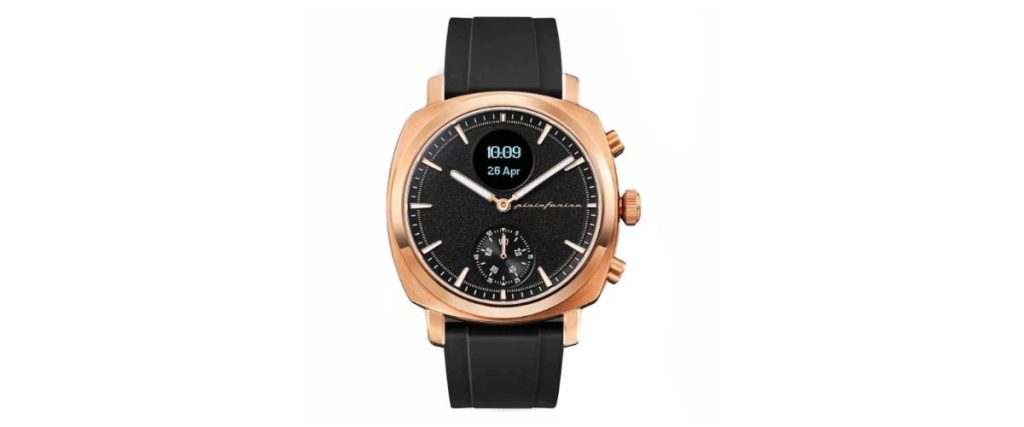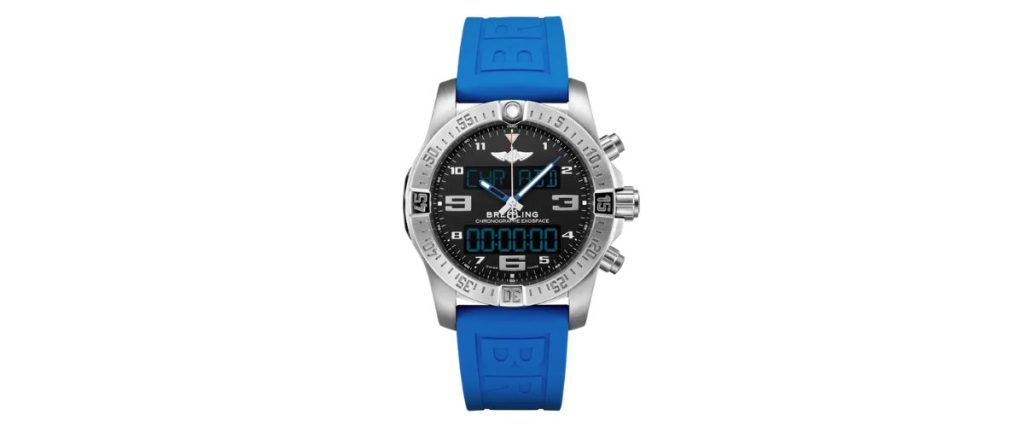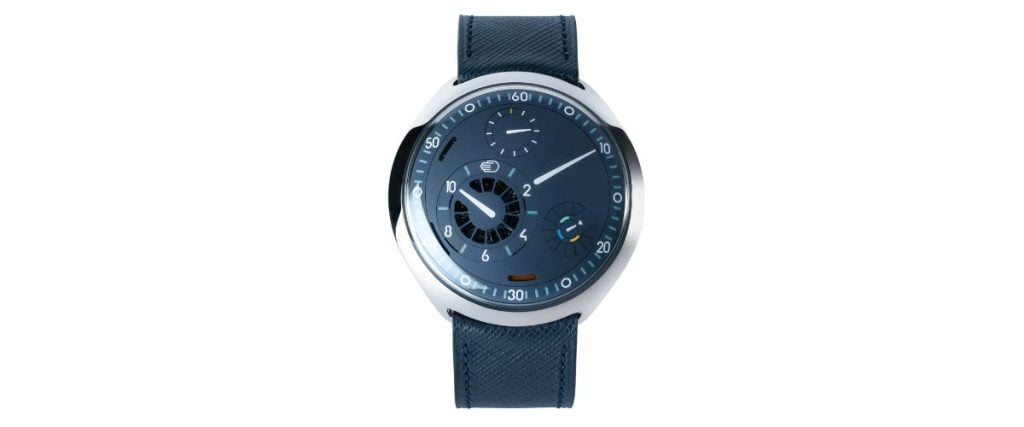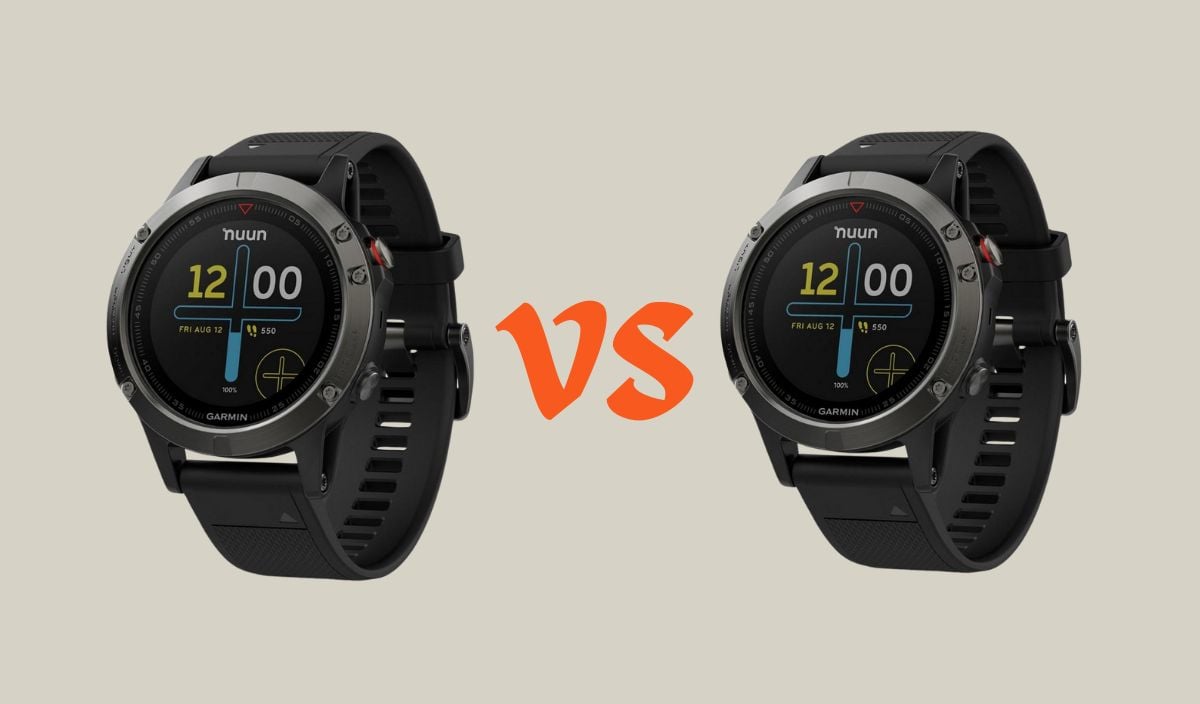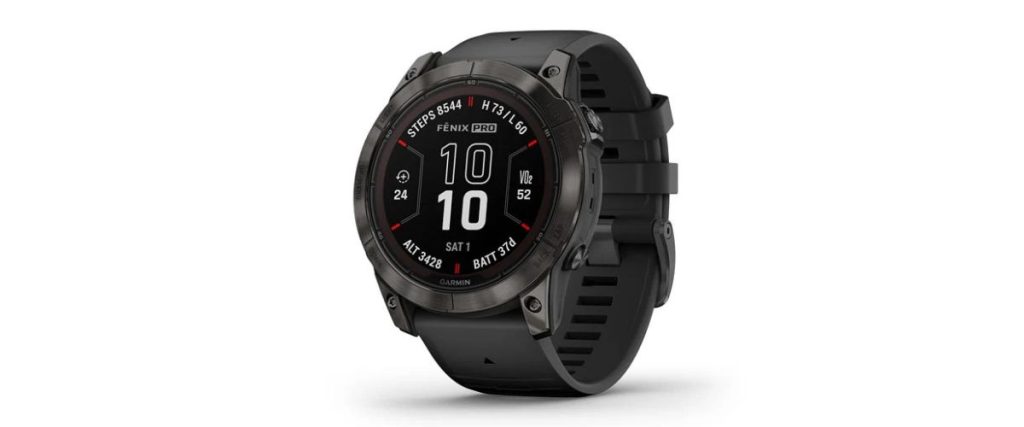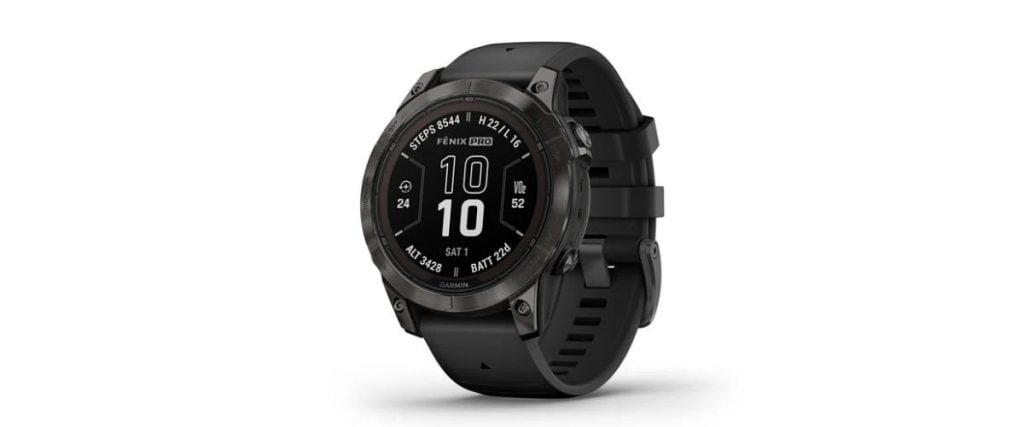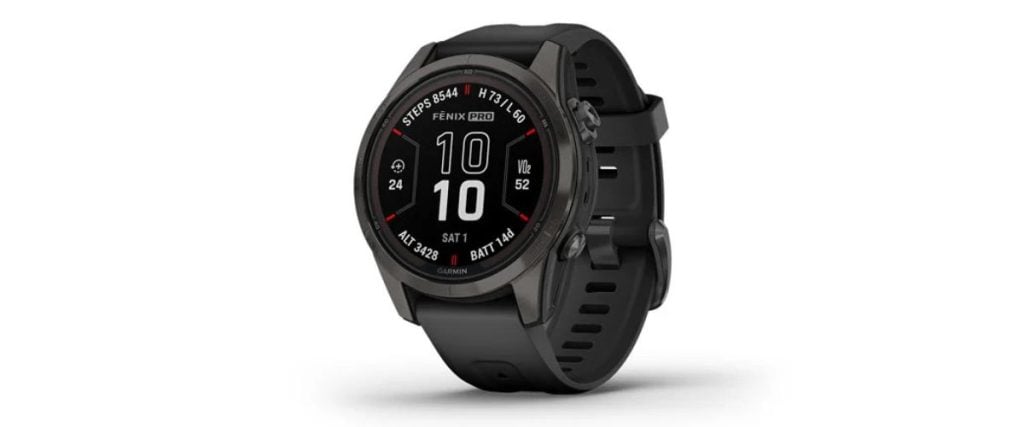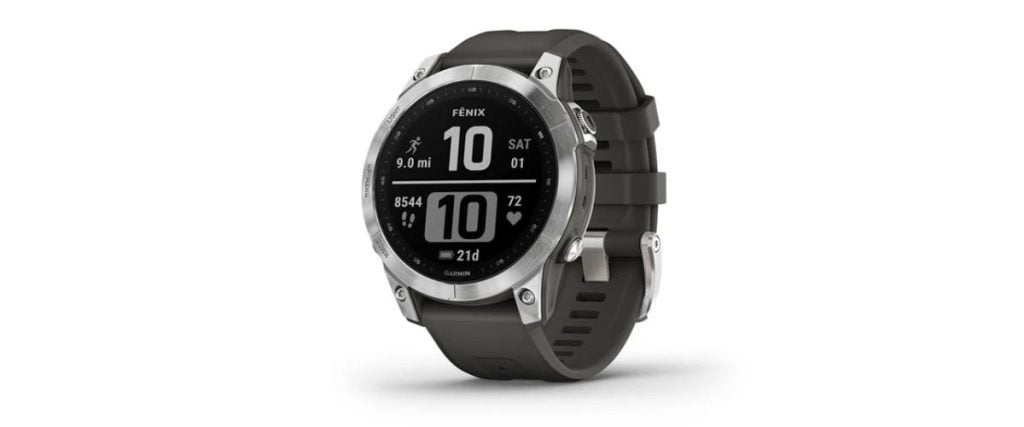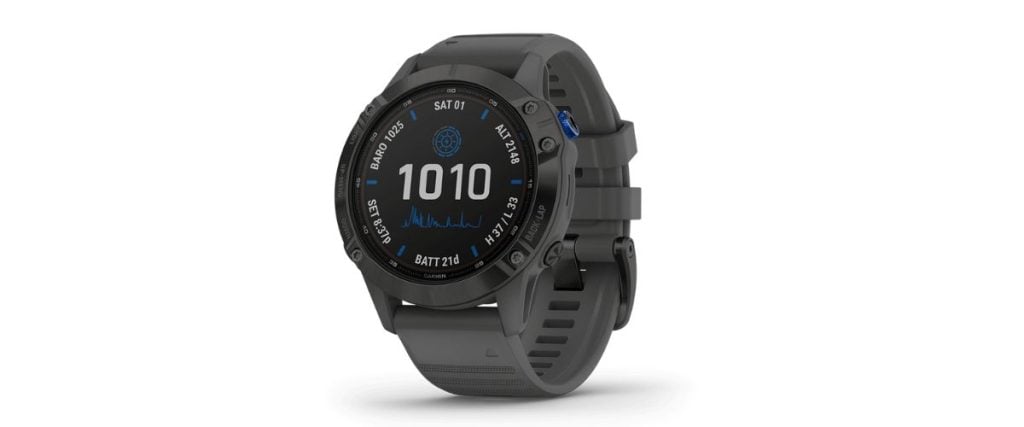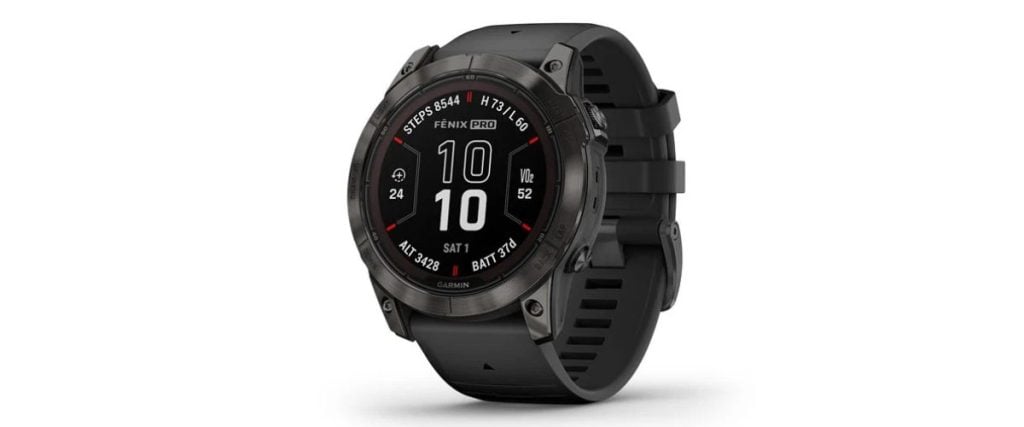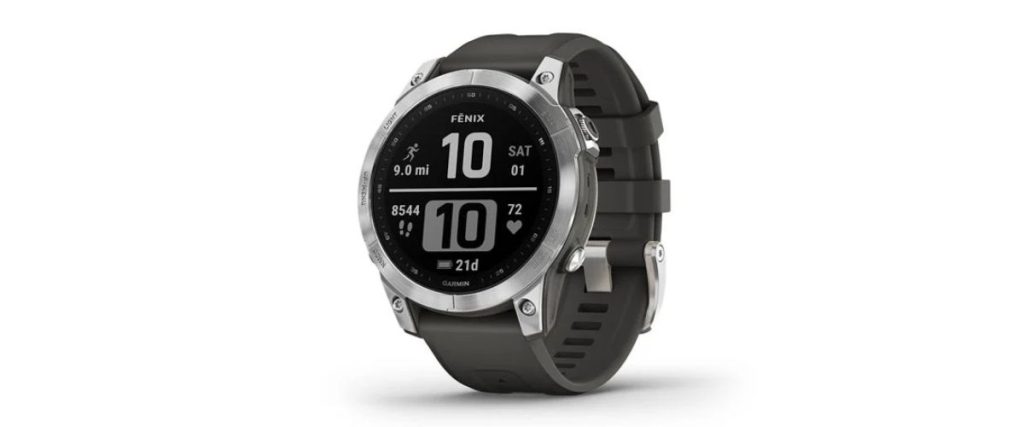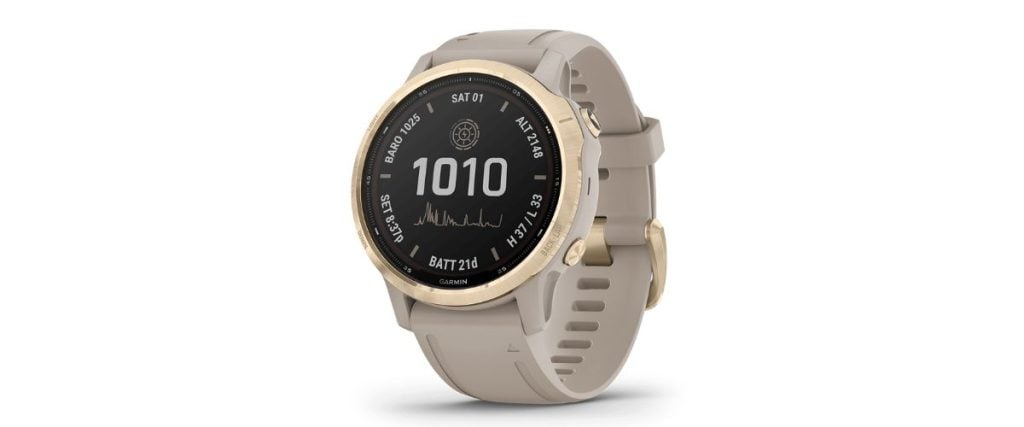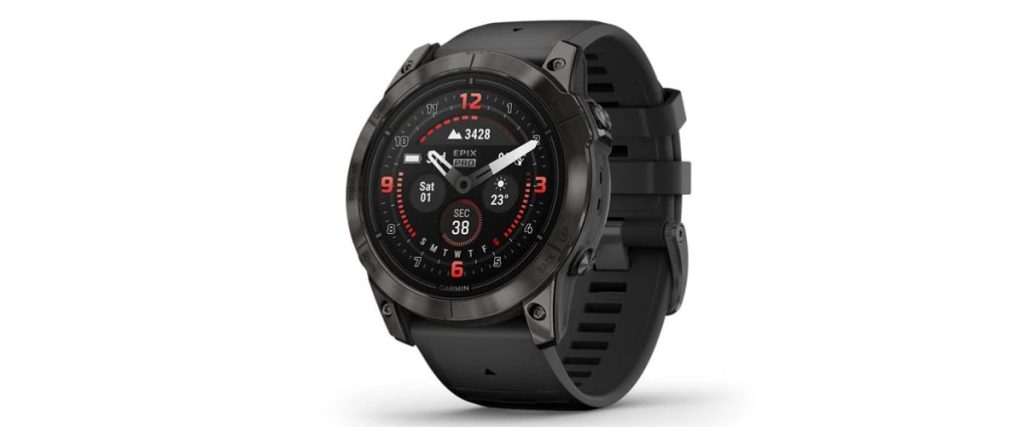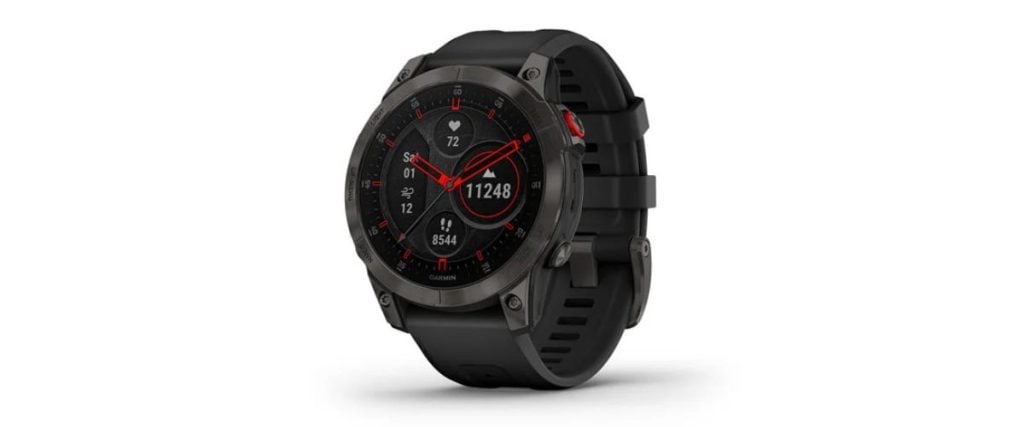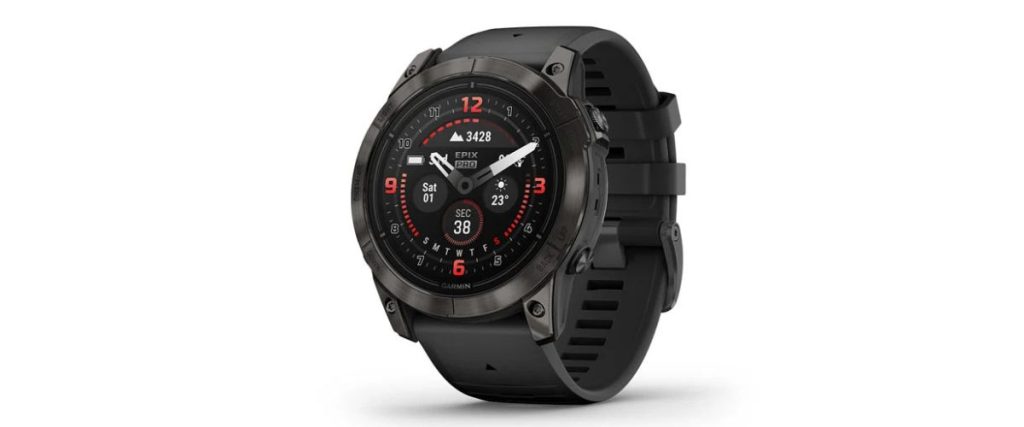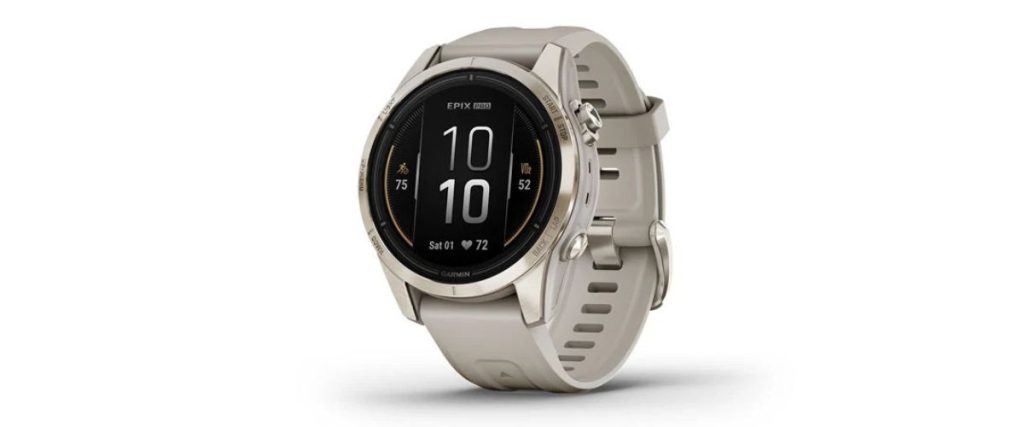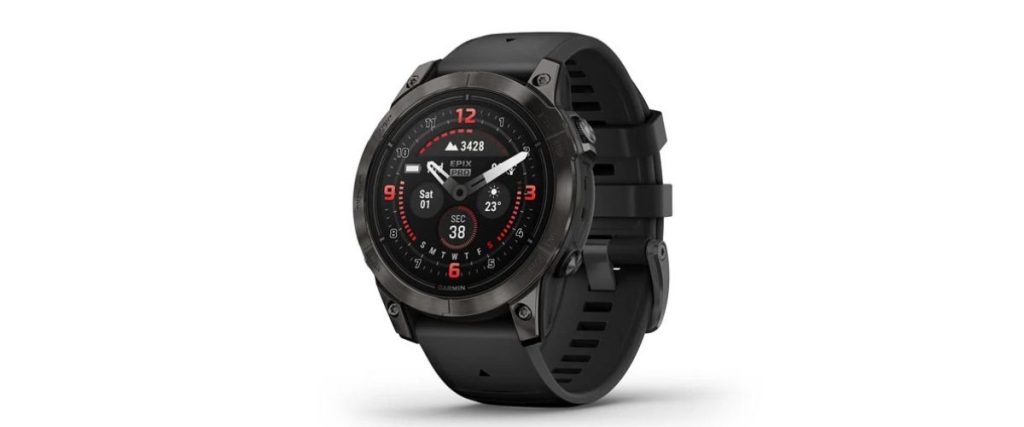
The Super Bowl isn’t just the biggest football game of the year, it’s watched by millions because it’s a full-blown spectacle of sports, style, and serious wrist candy.
With celebrities, athletes, and high-rollers all showing up, it’s no surprise that some of the most jaw-dropping timepieces make their way into the spotlight.
From iced-out luxury pieces to sleek, understated classics, the Superbowl watches on display are as impressive as the halftime show.
So whether you’re here for the touchdowns or the tickers, we’ve rounded up the 20 best Superbowl watches ever spotted at the Big Game.
Tom Brady’s Jacob & Co. Caviar Tourbillon (2025)

Only Tom Brady could show up to the Super Bowl not as a player and still steal the show with what was on his wrist. Spotted at Super Bowl LVIII, the GOAT rocked the mouth-watering Jacob & Co. Caviar Tourbillon decorated with yellow sapphires.
It’s without a doubt a statement piece, and one many of us could only dream of seeing, let alone wearing, retailing for a whopping $740,000.
With a manually-wound Caliber JCBM05 movement, a one-minute flying tourbillon, and a case set with hundreds of brilliant-cut sapphires and diamonds, it’s a watch that attests to its price tag.
It’s also limited to just 18 pieces worldwide which nicely reflects the kind of rarity Brady himself represents. It’s flashy, sure, but when you’ve got seven rings, why not add a tourbillon dripping in gemstones?
RRP: $740,000
Saquon Barkley’s Jacob & Co. Astronomia Solar Zodiac (2025)

When Saquon Barkley showed up at Super Bowl LVIII in head-to-toe denim, it was his wrist and his fit that caught our eye. The New York Giants star was sporting the Jacob & Co. Astronomia Solar Zodiac, a timepiece that feels more like wearable art than a traditional watch.
Priced at $348,000, it’s a showstopper and entirely fitting for a player known for electrifying moves and a commanding presence.
The watch features a domed sapphire crystal case housing a miniature solar system, with rotating gemstone planets, a 288-facet Jacob-cut yellow diamond as the sun, and a gold zodiac ring orbiting the dial.
Under the hood, the manually-wound Calibre JCAM19 keeps the celestial ballet in motion. At 43.4mm, it’s a substantial but elegant marvel that matches Barkley’s off-field confidence.
RRP: $348,000
Jay-Z’s Richard Mille RM66 Flying Tourbillon “Rockstar” (2025)

If there’s anyone who can turn a Super Bowl appearance into a moment of high fashion and horological envy, it’s Jay-Z. The music mogul and style icon arrived at Super Bowl 2025 with daughters Blue Ivy and Rumi, exuding effortless cool with a piece of wrist wear to match.
Spotted courtside at the Caesars Superdome, Jay-Z was wearing one of the rarest watches on the planet: the Richard Mille RM66 Flying Tourbillon “Rockstar” in Red-Orange Sapphire.
With only two pieces known to exist and a jaw-dropping price tag of $3.5 million, this watch is pure exclusivity.
The red-orange sapphire case is a first for Richard Mille, paired with a skeletonized movement and a rebellious “rock on” hand gesture at center stage.
It’s bold, unconventional, and unapologetically avant-garde, and on a night built for legends, it’s a timepiece that delivered the ultimate mic drop in watch form.Top of Form
RRP: $3.5 million
Jalen Hurt’s Patek Philippe Nautilus 5712R (2025)

Jalen Hurts arrived at Super Bowl 2025 with the kind of calm focus fans have come to expect but watch enthusiasts had something else to admire. On his wrist was the Patek Philippe Nautilus Moonphase Ref. 5712R-001, a rose gold timepiece that speaks to understated elegance and thoughtful taste.
It boasts the signature rounded octagonal case and asymmetrical dial layout, the former engineered from 18kt rose gold strapped on by a rich brown leather strap. Meanwhile, the dial proudly displayed a moonphase complication, date subdial, and power reserve indicator.
It’s a design that balances complexity and simplicity, much like Hurts’ playing style. While the stainless steel version of this model was recently retired, the 5712R remains in production and continues to hold its place as one of Patek Philippe’s most coveted Nautilus references.
RRP: $88,490
Jason Kelce’s Rolex GMT-Master II (2025)
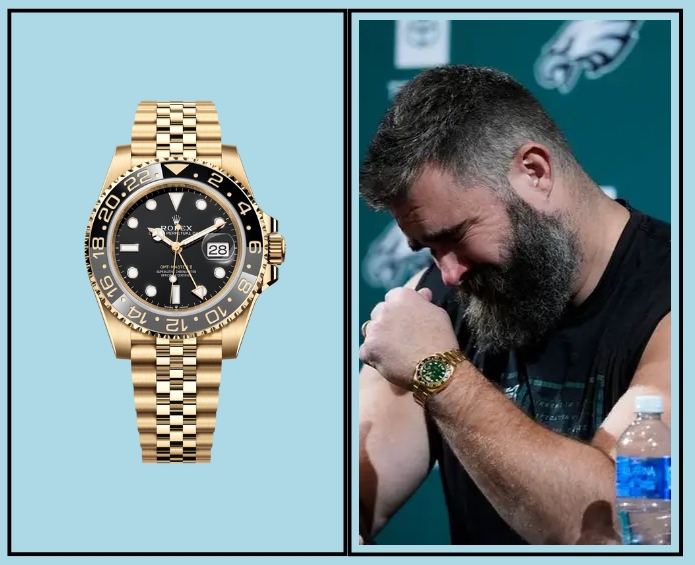
Jason Kelce has never been flashy, which is exactly why his Rolex GMT-Master II in solid 18K yellow gold stands out, not for its opulence, but for its meaning. It turns out this watch isn’t just a statement but a personal keepsake.
After the Eagles’ historic 2018 Super Bowl victory, the team’s first in 57 years, Kelce and several teammates commissioned this piece as a tribute. The caseback features a custom engraving of a dog mask, nodding to the “underdog” energy that defined that championship run.
The GMT-Master II 116718LN is a now-discontinued model, featuring a green dial and ceramic bezel. Originally built for pilots, it’s a fitting choice for Kelce, who now navigates life post-football as a father, podcaster, and fan favourite.
For someone who’s always prioritized grit over gloss, it’s nice to see someone wear a watch to the Superbowl that’s not about status but about memory, loyalty, and legacy.
RRP: $19,500
Michael Strahan’s Rolex Daytona “Rainbow” (2025)
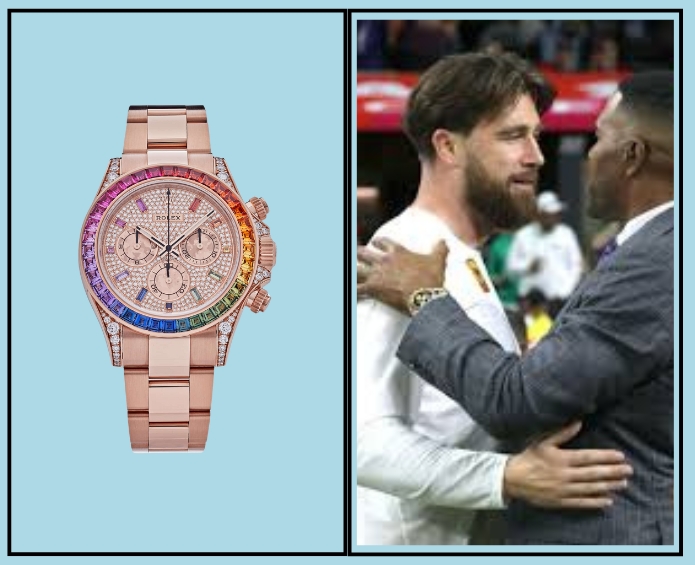
Michael Strahan knows how to bring presence, whether he’s on the football field, morning television, or the Super Bowl sidelines. At the 2025 game, it was the Rolex Cosmograph Daytona “Rainbow” on his wrist that drew quiet admiration.
Crafted in 18K yellow gold and fitted with the iconic Oyster bracelet, the watch features a bezel set with graduated sapphires in a full spectrum of color, paired with diamond hour markers on a sleek black dial.
Originally met with surprise when Rolex first introduced it, the Rainbow Daytona has become one of the most coveted gem-set pieces in modern watchmaking. It walks a line few watches manage being both dazzling yet sporty, bold but not loud.
For Strahan, who’s seamlessly moved from NFL dominance to daily TV screens, it feels like a fitting choice. The Daytona reflects not just his success, but his ease in navigating high-profile worlds without ever looking like he’s trying too hard.
RRP: $96,000 estimated
Serena Williams’ Audemars Piguet Code 11:59 Tourbillon Openworked (2025)
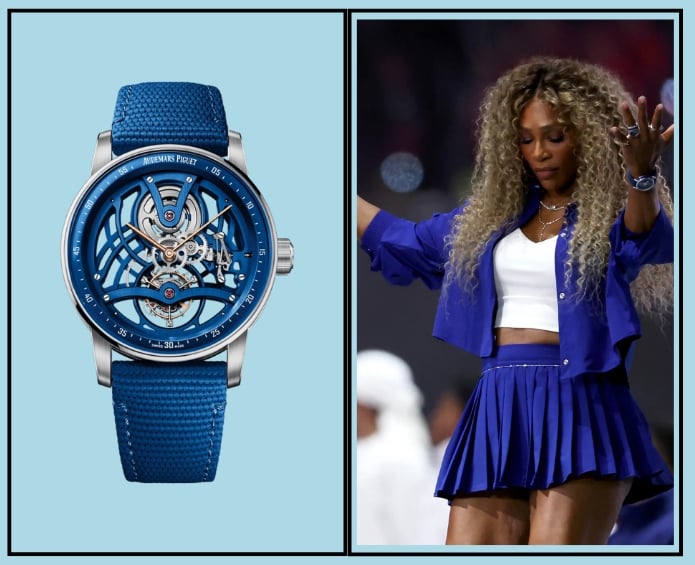
Serena Williams doesn’t miss on or off the court, and that was proven at the 2025 Super Bowl halftime show when the tennis legend made a surprise appearance wearing the Audemars Piguet Code 11.59 Tourbillon Openworked in Blue Ceramic.
This is a highly limited release with just 50 pieces worldwide and a strong signal that Serena, long-time AP ambassador, is all in on the brand’s bolder moves.
As for the design of the watch, it has a 41mm case that blends rich blue ceramic with an 18K white gold bezel and lugs. There’s also an openworked dial that reveals the hand-wound Calibre 2948 with a flying tourbillon at 6 o’clock.
With pink gold hands and a rubber-coated strap, it strikes a balance between technical prowess and modern sport-luxury.
RRP: £177,000 estimated
George Kittle’s Casio Calculator Watch (2024)

While most Super Bowl sidelines shimmer with six-figure timepieces and flying tourbillons, George Kittle went in a completely different direction at the 2024 game and honestly, we’re here for it.
The 49ers tight end showed up sporting a Casio Calculator Databank, the retro digital classic that’s more RadioShack than Rodeo Drive. And that’s exactly what made it stand out.
Wrapped in a gold-tone resin case, the Calculator watch isn’t about mechanical feats or precious metals. It’s about personality.
It’s the kind of watch you grew up punching math into during class, now elevated by pure confidence and zero pretension. In a sea of diamond bezels and skeletonized movements, Kittle’s choice felt refreshing and almost rebellious.
RRP: $90
Luke Combs’ Patek Philippe Nautilus Chronograph (2024)

At the 2024 Super Bowl, country music star Luke Combs was spotted in the stands with his wife, wearing a Patek Philippe Nautilus Chronograph 5980/1AR-001. This two-tone timepiece, combining stainless steel and 18K rose gold is a standout in the luxury sports watch category.
It features a 40.5mm case and a captivating blue gradient dial, complemented by rose gold applied hour markers with luminescent coating.
Its automatic movement, the Caliber CH 28-520 C, offers a 55-hour power reserve and powers a chronograph function with a 60-minute and 12-hour monocounter at 6 o’clock, as well as a date display at 3 o’clock.
The Nautilus line, designed by Gérald Genta and introduced in 1976, has become an icon of luxury sports watches so feels well suited to a luxury sports event like the Superbowl.
RRP: $180,000
Lil Jon’s Rolex Day-Date (2024)
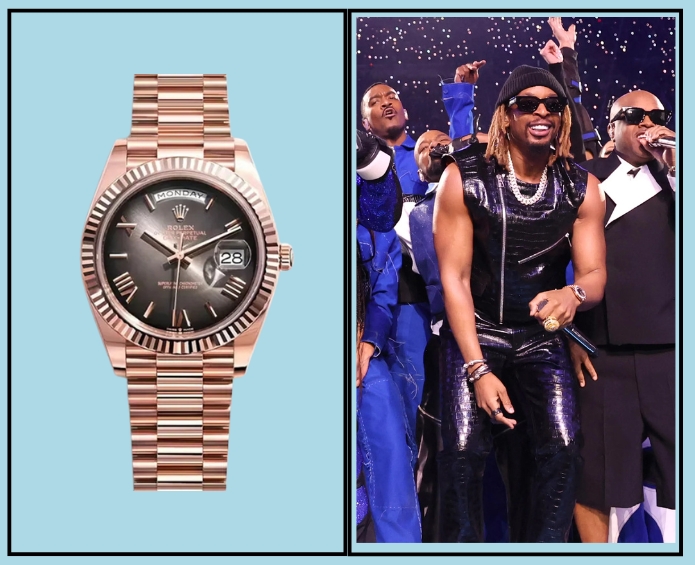
When Lil Jon takes the stage, he doesn’t do anything halfway, whether it’s his music or his choice of watch. During the 2024 Super Bowl LVIII halftime show, the rapper and producer showcased his larger-than-life personality with a statement timepiece: the Rolex Day-Date in 18ct yellow gold. This iconic watch perfectly complemented Jon’s energetic performance alongside Usher.
The Day-Date is no stranger to luxury, but Lil Jon’s version took it up a notch with its black dial and striking baguette-cut diamonds on the bezel.
Known for its presidential status and association with influential figures, the Rolex Day-Date is a symbol of success, and Jon’s bold style makes it the ideal match.
RRP: $80,000 estimated
Rihanna’s Jacob & Co. Northern Lights Red (2023)

While Lil Jon took centre stage in 2024, it was Rihanna that mastered the half time show in 2023 and as she did, she showed off the mesmerising Jacob & Co. Brilliant Skeleton Northern Lights Red. This is not your average watch but an absolute showstopper.
The 44mm stainless steel timepiece is set with a staggering 251 pavé diamonds, plus an additional 30 diamonds on the crown, so you just know it sparkled as brightly as Rihanna herself.
The piece’s red mineral crystal dial and red alligator strap perfectly matched her signature all-red Super Bowl outfit. But the real magic lies beneath the surface.
The transparent dial allows you to see the intricate skeleton movement, showcasing Jacob & Co.’s mastery in high watchmaking. Limited to just 101 pieces and with a retail price of $72,000, it’s a watch most of us female collectors will just have to keep dreaming of.
RRP: $72,000
Patrick Mahomes’ Rolex Day Date Platinum (2023)

When Patrick Mahomes steps onto the field, he’s not just wearing the Kansas City Chiefs’ success on his sleeve but he’s also wearing some serious wrist game.
For Super Bowl LVII in 2023, Mahomes made a statement with the Rolex Day-Date Platinum, a watch that quietly exudes luxury without the need for flashy braggadocio.
With a cool, ice-blue dial and set with 10 baguette-cut diamonds as hour markers, this platinum beauty is a perfect blend of understated elegance and high-end craftsmanship.
What really makes this watch stand out is the platinum construction paired with a bezel set with 40 baguette-cut diamonds.
Rolex’s long history with sports legends only adds to the prestige, and Mahomes’ choice to wear this particular reference (228396TBR) proves that he’s not just about winning on the field; he’s also got a keen eye for fine timepieces.
RRP: $100,000 estimated
Jay-Z’s Richard Mille RM47 Samurai (2023)
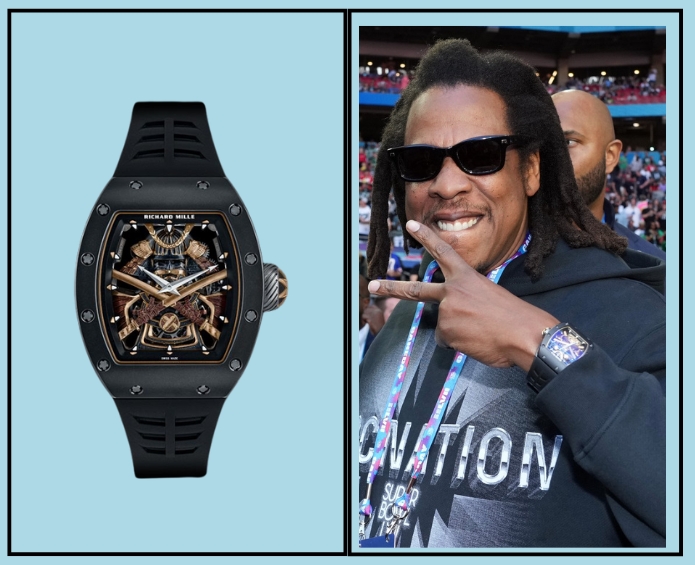
Jay-Z clearly has a deep appreciation for Richard Mille, and his 2023 RM47 Samurai is another standout in his enviable collection that he wore to the 2023 Super Bowl. Valued at around $1 million, this limited-edition timepiece is one of only 75 ever made.
Inspired by the story of Samurai warrior Asano Naganori, it features a tonneau-shaped case with intricate detailing, including a helmet adorned with the Asano family crest.
The watch’s armor is crafted from 3N yellow gold, hand-engraved and hand-painted for 16 hours. Equipped with a tourbillon movement and a 72-hour power reserve, the RM47 is as much a symbol of fine craftsmanship as it is a tribute to Japanese warrior culture.
RRP: $1 million
LeBron James’ Patek Philippe Nautilus Tiffany Blue (2022)
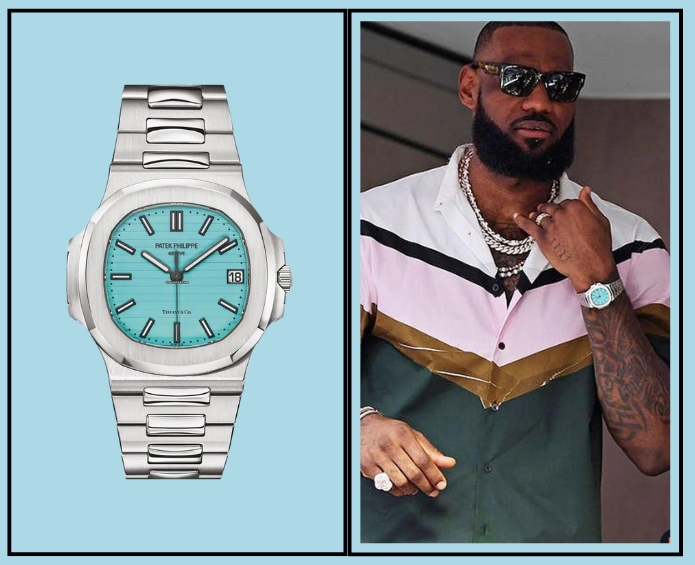
In 2022, no watch captured the cultural moment quite like the Patek Philippe Nautilus “Tiffany Blue” Ref. 5711. Limited to just 170 pieces, it instantly became the most talked-about release of the year—and a symbol of ultra-elite collecting.
So when LeBron James showed up to the Super Bowl that year wearing one, it was a perfectly timed power move.
Released to celebrate the 170th anniversary of Patek Philippe and Tiffany & Co.’s partnership, the watch originally retailed for $52,635 but now fetches millions on the resale market with one selling at auction for $6.5 million. With its instantly recognizable robin’s egg dial, the discontinued stainless steel Nautilus became a grail overnight.
RRP: $52,000
Eminem’s Rolex Datejust “Nugget” (2022)

Eminem may not have been the flashiest performer during the 2022 Super Bowl halftime show, but his wrist game quietly told a different story. The rapper wore a 36mm yellow gold Rolex Day-Date fitted with a custom yellow gold nugget bracelet.
Known for sticking to a single watch, Eminem’s loyalty to this Day-Date gives it even more weight. The nugget-style bracelet, popularized in the ’80s and ’90s, adds texture and personality to the otherwise classic Rolex silhouette.
It’s not the most extravagant piece seen that night, especially compared to his diamond-drenched peers, but that’s part of the appeal.
RRP: $25,000 estimated
Dwayne ‘The Rock’ Johnson’s Panerai Luminor Submariner Goldtech (2022)

Dwayne “The Rock” Johnson took the field at the 2022 Super Bowl with his signature bravado and a Panerai to match. While delivering his high-octane pre-game speech, watch fans were quick to spot the 44mm Panerai Luminor Submersible Goldtech OroCarbo strapped to his wrist.
Crafted from Panerai’s proprietary Goldtech, a robust alloy of gold, copper, and platinum, this watch blends luxury with action-hero ruggedness.
The deep red hue of the case, paired with a black ceramic bezel and caoutchouc rubber strap, makes for a bold yet refined wrist presence. The Rock is known for being a longtime Panerai fan and this choice proves his loyalty to the Italian-Swiss watchmaker once again.
RRP: $35,000
50 Cent’s Audemars Piguet Royal Oak (2022)
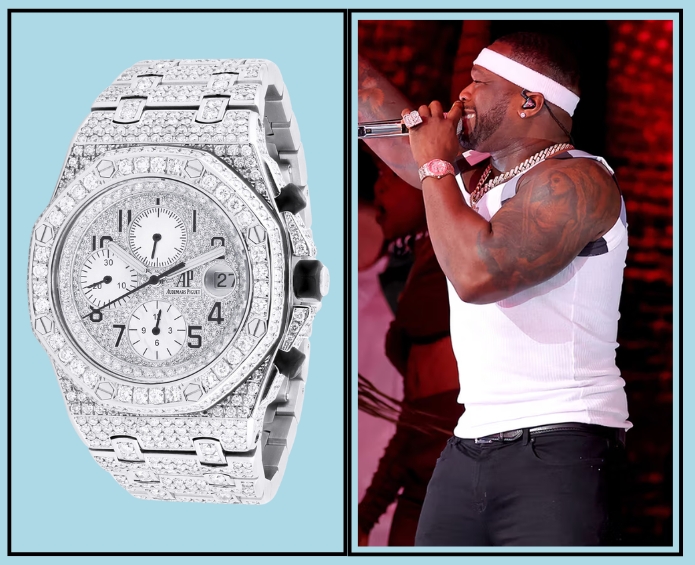
50 Cent made a dazzling entrance during the 2022 Super Bowl halftime show, hanging upside down and flexing a serious wrist game with an iced-out Audemars Piguet Royal Oak Chronograph.
The 41mm piece, crafted in 18k pink gold, was completely aftermarket set with over 70 carats of baguette-cut diamonds, earning it the nickname “The Chandelier.”
Paired with his diamond-dripping Cuban chain and signature “5” pendant, the watch was pure spectacle, matching the over-the-top energy of the performance.
It’s thought to retail around $235,000, so this really is a full-blown statement. I’m not sure I’d dare hang upside down with a watch this expensive on my wrist!
RRP: $235,000
Kevin Hart’s Audemars Piguet Royal Oak Self-Winding Chronograph
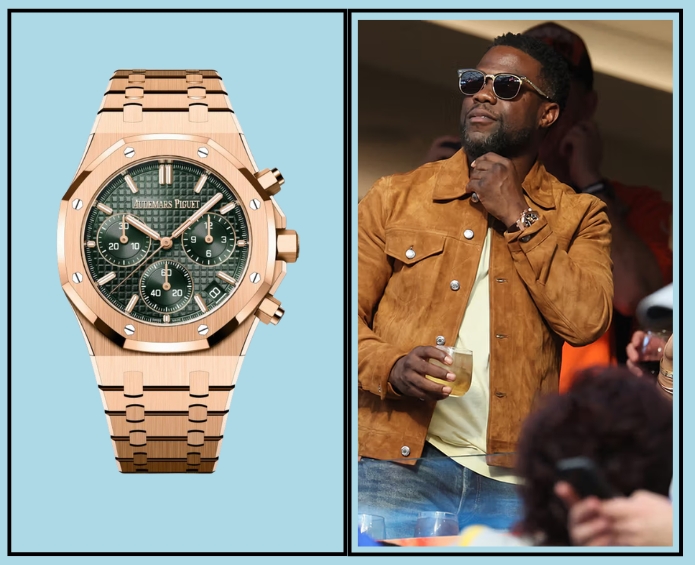
At the 2022 Super Bowl, Kevin Hart kept things classy with a refined flex: the Audemars Piguet Royal Oak Self-Winding Chronograph in rose gold.
Paired with a tan suede jacket and brown alligator strap, the watch brought effortless sophistication to the star-studded event.
This 41mm chronograph features a signature “Grande Tapisserie” patterned dial, gold applied hour-markers, and the iconic octagonal bezel secured with hexagonal screws. Inside ticks AP’s automatic calibre 4401 with flyback chronograph functionality and 70 hours of power reserve.
RRP: $100,000
Justin Bieber’s Rolex Day-Date “Jasper” Dial (2022)

In a Super Bowl packed with loud statements and even louder jewelry, Justin Bieber chose subtlety with serious pedigree. On his wrist was a Rolex Day-Date that was unlike almost anything else in the stadium, a rare 36mm reference fitted with a jasper hardstone dial.
Far from your typical gem-set Rolex, this watch is part of a quietly legendary run of “special dials” offered to select retailers during the 1980s. The jasper dial, rich in natural texture and color, features no hour markers, a design decision made to preserve the integrity of the brittle stone.
Crafted in 18k yellow gold and powered by Rolex’s calibre 3055 automatic movement, it’s a connoisseur’s piece through and through.
RRP: $52,500 estimated
Ellen DeGeneres’ Patek Philippe Nautilus Ref. 5711R (2022)
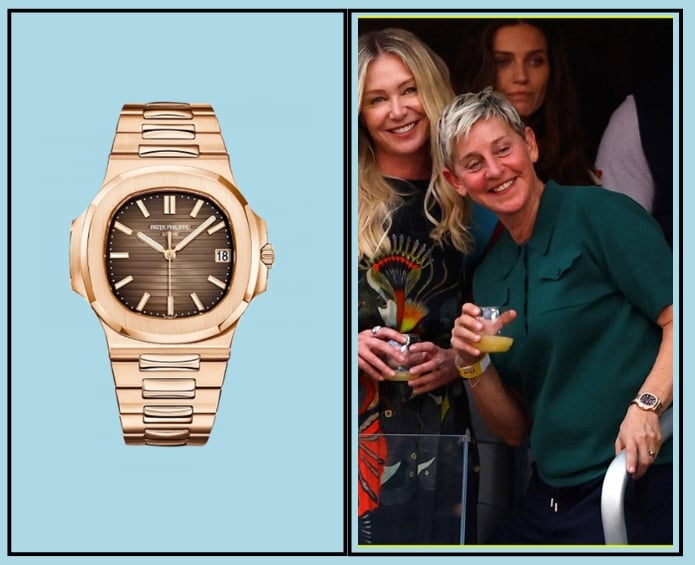
Finally, Ellen DeGeneres proved at the 2022 Super Bowl that she’s no stranger to horological heavyweights either. On the day, she was spotted wearing the Patek Philippe Nautilus Ref. 5711R in rose gold.
The 5711R houses Patek’s automatic calibre 324 S C, a beautifully finished movement visible through the sapphire case back, boasting a Gyromax balance and a 45-hour power reserve.
But the real magic lies in the exterior: the case and integrated bracelet showcase a masterclass in finishing, with brushed and polished surfaces playing with the light from every angle.
With its sleek design and understated elegance, the 5711R is proof that Ellen’s taste in watches is as sharp as her wit. Watching from the stands alongside her wife, Portia de Rossi (who wore a vintage GMT Master), Ellen once again reminded us she’s one of Hollywood’s true watch connoisseurs.
RRP: $150,000 estimated
Conclusion
In many ways, the Super Bowl is the ultimate stage, not just for football, but for fashion, flexing, and fantasy-level watches. From ultra-rare Richard Milles to iced-out Rolexes and galaxy-themed Jacob & Co. creations, these timepieces let us live out our wildest horological dreams through the TV screen.
It’s fun to marvel at what the rich and famous have access to, and for watch lovers, it’s a reminder that the Super Bowl isn’t just about touchdowns but tourbillons, too.
Whether you’re here for the game, the halftime show, or the wristwear, the Big Game never disappoints when it comes to seriously exclusive and undeniably expensive timepieces.


